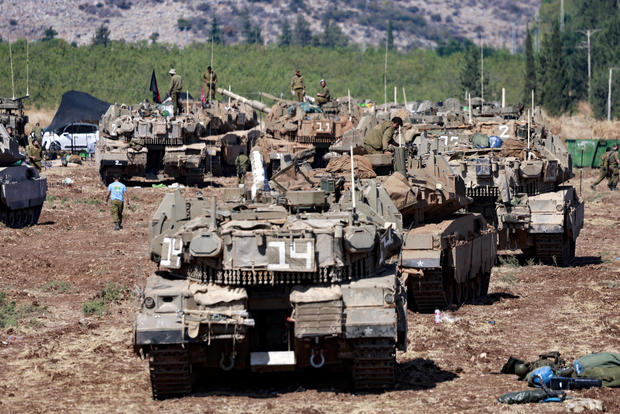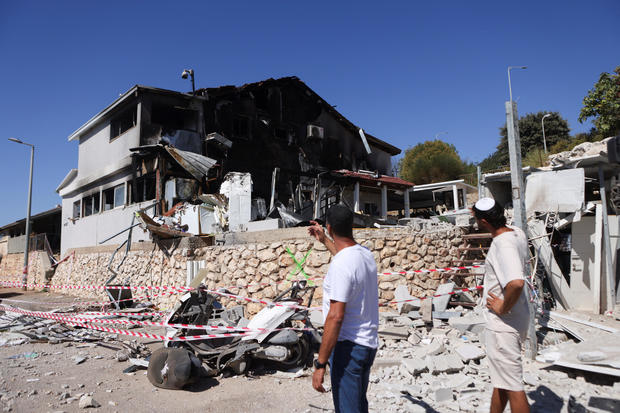
Why Israel says it must attack Hezbollah on the ground in Lebanon, as a U.S. official says Iran could strike Israel
Almost a year after Israel launched its war against Hamas in the Gaza Strip in retaliation for the Iran-backed group’s Oct. 7 terrorist rampage, it announced the beginning of what the Israel Defense Forces said would be “limited, localized, and targeted ground raids” against Iran’s much larger, better-armed proxy group Hezbollah in Lebanon. A White House official said, meanwhile, there were indications that Iran was preparing to launch ballistic missiles at Israel amid the escalating tension in the heart of the Middle East, warning against such retaliation.
The Israeli ground operations were announced after about two weeks of blistering airstrikes on Hezbollah strongholds in southern Lebanon and the southern suburbs of Lebanon’s capital, Beirut, which have killed more than 1,000 people and displaced about 1 million people from their homes, according to Lebanese officials.
The aerial assault — and unprecedented covert operations before it that saw thousands of pagers and walkie-talkies held by Hezbollah militants blown up with embedded explosives — largely decapitated the U.S.-designated terrorist organization. Its longtime leader Hassan Nasrallah was killed in an airstrike on Sept. 27, and at least half a dozen other senior figures, and dozens of mid-level operatives, have also been killed. But even as Israel prepared to launch its ground operation, Hezbollah’s surviving deputy leader said the group was ready for war.
said in the message. “We will let you know when it is safe to return home.”
While the extent of the looming incursion remained unclear, at an IDF staging area just south of the Lebanese border, it was apparent that Israeli forces were preparing, at least, for a significant assault.
MENAHEM KAHANA/AFP/Getty
Dozens of tanks, armored fighting vehicles and bulldozers were lined up, ready for orders, and the IDF announced later Tuesday that it was calling up four more reserve brigades for missions on the Lebanon border, to “enable the continuation of operational activity against the Hezbollah terrorist organization.”
On the other side of the border, tens of thousands of Hezbollah fighters — with a vast tunnel network, a reputation for guerrilla warfare and suicide bombings — were dug in, waiting to defend the territory they have controlled for decades.
The last war, in 2006, ended with a cease-fire, and a United Nations peacekeeping mission of around 10,000 troops has been deployed near the border in Lebanon, along the so-called Blue Line, ever since. That mission, the United Nations Interim Force in Lebanon, called Israel’s plans to launch cross-border ground operations a “dangerous development,” noting that its “peacekeepers remain in position.”
“Peacekeeper safety and security is paramount, and all actors are reminded of their obligation to respect it. Any crossing into Lebanon is in violation of Lebanese sovereignty and territorial integrity,” UNIFIL said in a statement. “We urge all actors to step back from such escalatory acts, which will only lead to more violence and more bloodshed.”
Why is Israel attacking Hezbollah in Lebanon?
Israeli officials have said the goal of the operations against Hezbollah is to enable roughly 60,000 people forced to flee their homes in the northern part of the country to return. They were driven away — under evacuation orders in many cases — by a hail of rocket, drone and missile fire launched by Hezbollah militants inside Lebanon.
That onslaught, albeit largely ineffective thanks to Israel’s advanced missile defense systems, began the day after Israel started bombing Hamas targets in Gaza in the wake of the Oct. 7 terrorist attack. That massacre saw Hamas and allied terrorists kill some 1,200 people in southern Israel, and take 251 others as hostages back into Gaza, according to Israeli officials.
Jim Urquhart/REUTERS
Since then, Israel says Hezbollah has fired more than 8,000 weapons across Lebanon’s southern border. The vast majority of the projectiles are intercepted, but some do crash down, and a handful of people have been wounded in northern and central Israel by the attacks, including two men hurt by rockets that hit a bus and another vehicle on Oct. 1. The most lethal attack was a rocket that slammed into a soccer field in the Israeli-controlled Golan Heights in July, killing 12 young people. Hezbollah denied firing the rocket, but Israel and the U.S. blamed the group.
Israeli Prime Minister Benjamin Netanyahu has vowed to force Hezbollah back from the Lebanon border far enough to stop the barrage of rocket fire, so the displaced residents of northern towns and villages can go back to their homes.
“The reality is that, prior to October 7th, there was always a vulnerability [from Hezbollah], but Israel always thought it had been tamed,” Sanam Vakil, director of the Middle East and North Africa Program at the global affairs think tank Chatham House, told CBS News in September. “What October 7th has done, I think for Israel and Israelis, is reawaken them from, you know, that mirage that they were safe and secure. So going back to October 6th without altering the balance of power on Israel’s borders and within Israel seems hard to do.”
“We all feel suffocated by the situation. We don’t breathe,” Sarit Zehavi, a researcher who worked for 15 years in Israeli military intelligence and lives in northern Israel, told CBS News before the ground operations began. “On October 8th, basically, the war started here, with Hezbollah.”
Getty/iStockphoto
Speaking with CBS News again on Oct. 1, Zehavi said she hoped the overall Israeli military operation against Hezbollah “will succeed — that we will succeed in eliminating all the [Hezbollah] ground infrastructure in the area next to the border.” But she recognized that a military assault alone was unlikely to ensure peace for northern Israel in the longer term.
“To tell the truth, I hope it will end with some kind of diplomatic arrangement that will enable us to breathe many more years, because they [Hezbollah] will strive to recover… After what happened on October 7th, you can no longer see Hezbollah on the other side of the border. This is the threat we cannot live with anymore.”
The U.S., Iran, and the risks of a Israel-Hezbollah war
For weeks, President Biden has called for a cease-fire as Israel and Hezbollah exchanged increasing fire over the southern Lebanon border. U.S. officials at the White House, State Department and Pentagon have all made clear the risks of an all-out war between the close American ally and Iran’s most powerful proxy force in the heart of the Middle East could spiral into a broad regional conflict.
Those concerns appeared to be growing more acute in Washington, with a senior White House official telling CBS News on Oct. 1 that there were “indications that Iran is preparing to imminently launch a ballistic missile attack against Israel.”
“We are actively supporting defensive preparations to defend Israel against this attack,” the official said, adding that any direct “attack from Iran against Israel will carry severe consequences for Iran.”
On Sept. 30, Pentagon Deputy Press Secretary Sabrina Singh told reporters that a number of American units already in the Middle East would have their deployments extended, and the forces due to replace them would instead overlap. That includes F-16, F-15E, A-10 and F-22 fighter aircraft and the personnel who operate the planes, she said, amounting to an increase of an “additional few thousand” U.S. troops in the region.
Iran backs a number of groups across the region, including Hezbollah, Hamas and the Houthi rebels in Yemen. Tehran refers to these groups as a “resistance front” against Israel’s decades-long occupation of Palestinian territory, while Israel refers to it as an axis of evil with the ideological goal of wiping the Jewish state off the map.
Fears of regional conflict intensify as Israel strikes Yemen
02:28
Hezbollah’s calls its rocket and drone attacks on Israel a legitimate support and defense of Palestinians in Gaza and the Israeli-occupied West Bank, and the Houthis have claimed the same rational for their months-long targeting of commercial and military vessels in the Red Sea.
One of the biggest risks, from a U.S. security perspective, is that Iran’s proxy groups — including smaller militias based in Iraq and Syria — will target American forces in the region in retaliation for Washington’s support of Israel. They have done so already since Oct. 7, firing rockets or drones at U.S. bases and other installations more than 165 times. Most of the attacks cause little to no damage, but a January drone assault on a U.S. outpost in Jordan, claimed by an Iran-backed group in Iraq, killed three U.S. troops and wounded dozens.
Despite the risks and Washington’s calls for deescalation, however, Israel has appeared determined to seize the momentum, with Hezbollah on a back foot in the wake of the aerial bombardment. The message has been clear: The best way to deescalate the war, from Israel’s perspective, is to win it.
contributed to this report.
More
More
Source: cbsnews.com

